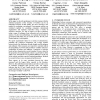Free Online Productivity Tools
i2Speak
i2Symbol
i2OCR
iTex2Img
iWeb2Print
iWeb2Shot
i2Type
iPdf2Split
iPdf2Merge
i2Bopomofo
i2Arabic
i2Style
i2Image
i2PDF
iLatex2Rtf
Sci2ools
WWW
2006
ACM
2006
ACM
The web structure of e-government - developing a methodology for quantitative evaluation
In this paper we describe preliminary work that examines whether statistical properties of the structure of websites can be an informative measure of their quality. We aim to develop a new method for evaluating e-government. E-government websites are evaluated regularly by consulting companies, international organizations and academic researchers using a variety of subjective measures. We aim to improve on these evaluations using a range of techniques from webmetric and social network analysis. To pilot our methodology, we examine the structure of government audit office sites in Canada, the USA, the UK, New Zealand and the Czech Republic. We report experimental values for a variety of characteristics, including the connected components, the average distance between nodes, the distribution of paths lengths, and the indegree and outdegree. These measures are expected to correlate with (i) the navigability of a website and (ii) with its "nodality" which is a combination of hub...
Better Navigability | E-government Websites | Internet Technology | Respective National Populations | WWW 2006 |
| Added | 22 Nov 2009 |
| Updated | 22 Nov 2009 |
| Type | Conference |
| Year | 2006 |
| Where | WWW |
| Authors | Vaclav Petricek, Tobias Escher, Ingemar J. Cox, Helen Margetts |
Comments (0)

